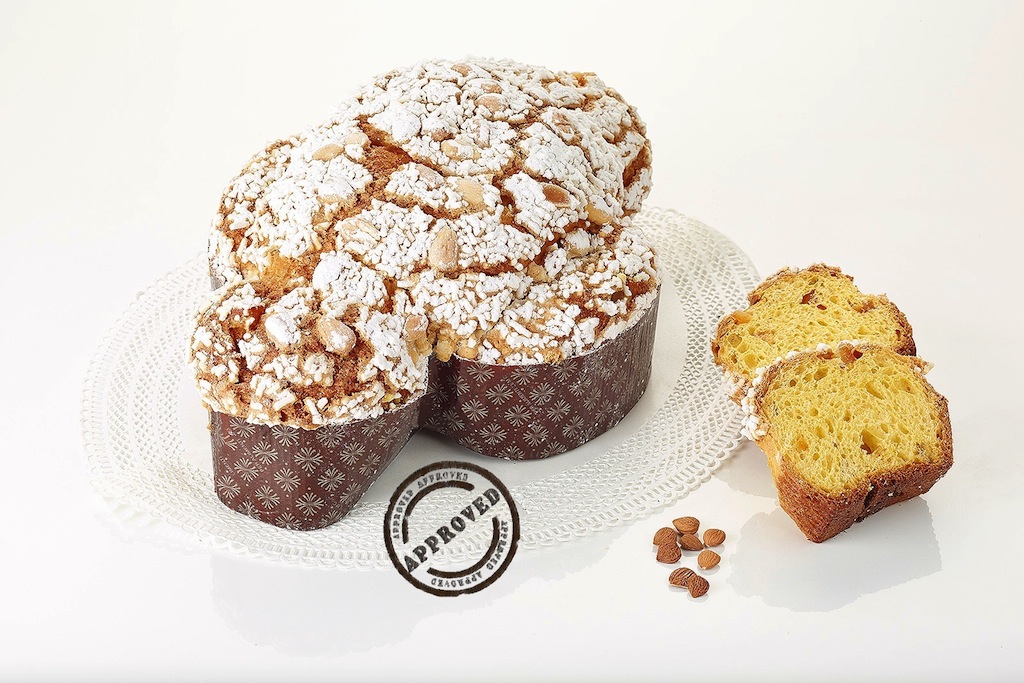Easter dove (Colomba)

The Easter dove (Colomba), as well as the Easter egg, belongs to the Italian Easter tradition: its origins go back to the half of the 6th century, when the town of Pavia was under siege by the Longobard King Alboino, who was given a dove-shaped bread as a peace offering. A more recent and realistic explanation says that, at the beginning of the 20th century, the Milanese firm Motta created a sweet Easter bread, that was similar to panettone: this is the origin of the Easter dove as we know it, a naturally leavened bread with candied fruit and a crunchy glazed almond topping.
250 grams of butter
1 lemon peel, grated
1 orange peel, grated
12 grams of fresh yeast
150 grams of candied fruit, cedar and orange
50 grams of honey
180 milliliters of whole milk
1 vanilla, pod
1 teaspoon of malt syrup
6 egg yolk
6 grams of table salt
550 grams of manitoba flour
230 grams of sugar, custer, grain
50 grams of almonds
80 grams of powdered sugar
2 white egg
80 grams of almonds
The difficulty of the Easter dove recipe lies in the long and laborious preparation time; you don’t have to be in a hurry, to allow the dough to rise properly.
1: crumble the fresh yeast in a bowl, then add 1/5 cup (50 ml) of lukewarm milk, the malt and ¾ cup (100 g) of flour. Knead it into a ball, then let it rise, covered with cling film, in a warm place (the turned-off oven with the light turned on, for example) for at least 30 minutes.
2: take the risen dough and knead again, adding 1/3 cup (80 ml) of lukewarm milk and ¾ cup (100 g) of flour: once the dough is soft, let it rise in the same place as before for at least 30 minutes.
3: take the risen dough, add 1 cup (150 g) of flour, just under ½ cup (80 g) of sugar and 1/5 cup (50 ml) of lukewarm milk and knead everything for at least 15 minutes; then blend in ¾ stick (80 g) of softened butter, a little at a time, beating until completely absorbed. Once the dough is even and elastic, form into a ball, transfer to a bowl covered with cling film and place in the turned-off oven, with the light turned on, for at least 2 hours.
4: take the risen dough and add ¼ tbsp (5 g) of salt, ½ cup (100 g) of sugar, the vanilla, the grated orange and lemon zest, the honey and the eggs, alternating with the addition of 1 ½ cups (200 g) of flour; finally blend in 1 ½ sticks (170 g) of softened butter a little at a time. Knead until you have a smooth, elastic dough, then add the orange and citron candied peel. Form into a ball and let it rise in a bowl, which has been greased with butter, for about 12 hours.
5: take the risen dough, transfer to a work surface and knead for a few minutes, then place it in the dove-shaped paper baking mould and let it rise until doubled in volume (at least 3 hours).
Meanwhile prepare the topping: with a fork, beat the egg whites in a bowl, adding the powdered sugar and the almond flour (or toasted hazelnut meal, if you prefer) little by little. Beat until you have a thick mixture, that doesn’t run down the sides of the cake. After the rising time, cover the dove cake with the resulting mixture and sprinkle the almonds and the sugar grains (50 g) all over.
Bake the Easter dove bread in a preheated static oven at 390°F (200°C) for the first 10 minutes, then lower the temperature to 350°F (180°C) and bake for another 30-40 minutes (test for doneness with a toothpick).
Take the Easter dove out of the oven, let it cool, then lightly sprinkle with vanilla powdered sugar and serve!
Author: giallozafferano
